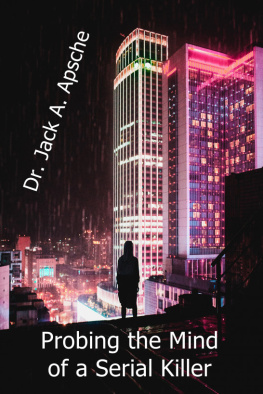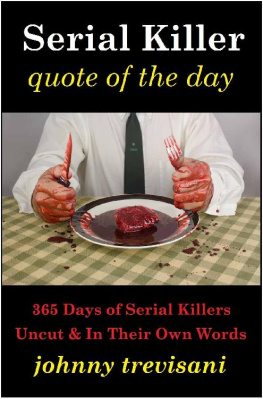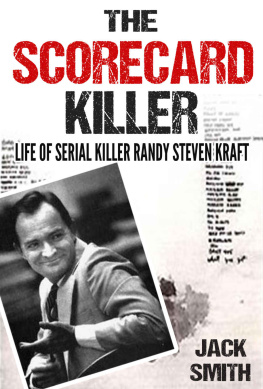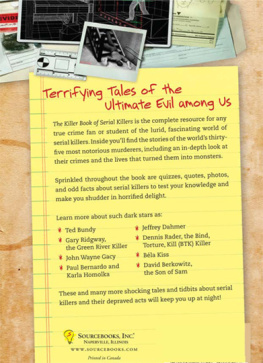Probing the Mind of a SerialKiller
by
Jack A. Apsche
Foreword by
A. Charles Peruto,Jr.
Published byePrintedBooks
SmashwordsEdition
Copyright Statement
No part of this book may be reproducedor transmitted in any form or by any means, electronic ormechanical, including recording, photocopying, or by anyinformation storage and retrieval system, without the writtenpermission of the publisher.
DEDICATION
This book is dedicated to Robert K.Ressler. We would still be standing near, and looking into theabyss without his pioneering effort. Thank you Mr.Ressler.
THANKS STUFF
It seems appropriate to thank thosepeople who, in a variety of ways, allowed this book to becompleted. So, thank you, one and all.
Included among these thank yous aremy daughter, Melissa, who thinks that its cool, and my son,Joey, who just wanted to see it done.
An especially big thanks goes to mywife, Joanne, who had to live through all the phases of this work,and the writing of the book and shes still married to me! Thankyou, I love you.
Finally, thanks to Richard Bradley.Without his belief in this project, and because of his guidelines,we were able to complete it. You were right, there was a book inthere somewhere. I hope I found it.
Finally, it is my hope that this bookcontributes to continued research and understanding into thephenomena of serial killers. As such, I thank you, the reader ofthis book.
Table of Contents
Jack Apsche holds a doctorate inPsychological Studies from Temple University in Philadelphia. He iscurrently pursuing an advanced degree in Criminal Justice. Dr.Apsche is a researcher, author, lecturer, and consultant Hiscuriosity in human behavior extends well beyond serial killers,from the everyday problems of everyday people, to the particularproblems of Viet Nam veterans, the behavior of organized crime andlaw enforcement, and the rise of the German neo-Nazi movement Hisresearch centers on the quest to uncover the reasons for thebehavior differences between the saints, the sinners, and therest of us.
Dr. Apsche lives with his wife andfamily in Levittown, PA.
You may wonder why an attorney iswriting a foreword for a psychology text, but the sanity orinsanity of serial murderers is an important legal issue. In fact,whether or not a person is insane is not a mental health issue atall, it is a legal judgment. Acknowledged mentally ill individuals,even those who have committed unimaginable serial or ritualisticmurders, are not necessarily insane under the law.
Think about it. When you hear about aserial killing, and see and hear just part of the actual details ofthese events from the all pervasive TV network news, your firstreaction is that the killer is insane. Youd have to be crazy toeven think of the things that were done! But, those killings arefrightening, horrifying and, at the same time, somewhat compelling.The media knows this and plays to all these feelings.
How could anyone in their right mind dosuch terrifying things to another human being? Its hard tounderstand the motive. For mental health professionals, lawenforcement, judges, attorneys, and juries understanding the motiveis a problem. This lack of understanding allows severely mentallyill individuals to slip in and out of mental health care for years even decades, until it is too late and the killing begins. Itmakes apprehension of these individuals by law enforcementdifficult, because the motive is missing at least to the normalindividual. And once brought into court, judges, juries andattorneys, still not understanding, but knowing the killer must becrazy become entangled in a legal definition over 150 yearsold!
Part of the problem is the shock at thegrotesque details of the actions and the need for society to riditself of this particular menace. The serial killer, as you willsee, is generally extremely intelligent and appears to behave, andanswer questions rationally. In fact, most are always helpful andhave learned to tell you what you most want to hear. But the worldthat exists only in their head almost never appears.
Popular culture, books, movies and TVshows portray the serial killer in his external image only. Thecharacter never appears crazy but pursues the relentless killingpath in a logical rational manner. Theres no wild-eyed madman asis often portrayed by actors like Jack Nicholson but a calm,reasoning killer trying to outsmart the system. This is also whathappens in real life. But as Dr. Apsche points out in this book,the serial killer lives an internal fantasy world that cannot beseen or understood by those who see him. Juries are then easilymanipulated to change their gut feel of insane to sane whenconfronted by the archaic definition, and the authority of ajudge.
This book begins the discovery of theinner world of the serial killer. It shows these individuals tohave had mental problems that were being treated for years. Itshows how the intelligence of these individuals get them releasedfrom institutions over and over again. Released until theirfantasies take complete control and are acted out. And oncesuccessfully acted out, these powerful fantasies and the feelingsof control become stronger and stronger leading to furtherkillings.
To understand this in the detailpresented by Jack Apsche, often using the words of an actual serialkiller can help society better than all the death penalties andlife-in-prison sentences ever can. Knowing what to look for, how tofind and understand the fantasy motive, can help law enforcementpersonnel find these people quicker. Our legal system, juries,attorneys and judges, can then interpret the law in a manner tohelp society by placing these insane killers in a secure placewhere they can be studied and helped. They cant be cured, but theycan help us understand the disease and help prevent future crimesfrom being committed.
Perhaps most importantly is theacknowledgment by mental health professionals psychiatrists andpsychologists that the serial killer is an unrecognized mentalhealth illness. As Dr. Apsche points out these individuals exhibitmany of the more traditional and recognized forms of mentalillness, but the whole is more than the sum. As the researchcontinues on from the beginnings presented in this book, theserial/ritualistic killer category will become better defined,understood and accepted. Then these people can be reached, confinedand treated when they first are admitted for mental health care,not waiting for the victims to be found years later. This bookcannot bring back the victims, or console their families andfriend. Neither can it prevent these crimes from taking place inthe future at least not by itself. But Dr. Apsches work offersthe first insight and plan for further work that will begin tocontrol the centuries old horrifying crime the serialkilling.
A. Charles Peruto, Jr.
Philadelphia, Pennsylvania
John 3:20: For everyone who does wickedthings hates the light and does not come toward the light, so thathis works night not be exposed.
one of Gary Heidniks favorite Biblepassages.
Although so called serial orritualistic murders have probably been around since there wasenough human beings to form even the most primitive society, itseems that in the last several decades that the incidents of thesehorrific crimes has been increasing. In fact, there may have beenno significant increase in this type of crime at all [on a percapita basis]. Although impossible to prove, much of the seemingincrease, may be nothing more than an increase in awareness of thecrimes. Awareness traced to coverage by modem media.
Modem media television, newspapers,news magazines, and radio now reports these sorts of crimesalmost immediately after they have been discovered. Not only arethe reports instantaneous and available to more people now thenthey ever have been, but they are reported with a graphic detailthat brings home the horror of the crime to all who hear or see thenews. In addition, advances in psychology, forensic science, andcrime detection have identified such crimes for what they are,rather than strange unsolved murders which have filled police filesin the past.
Next page











